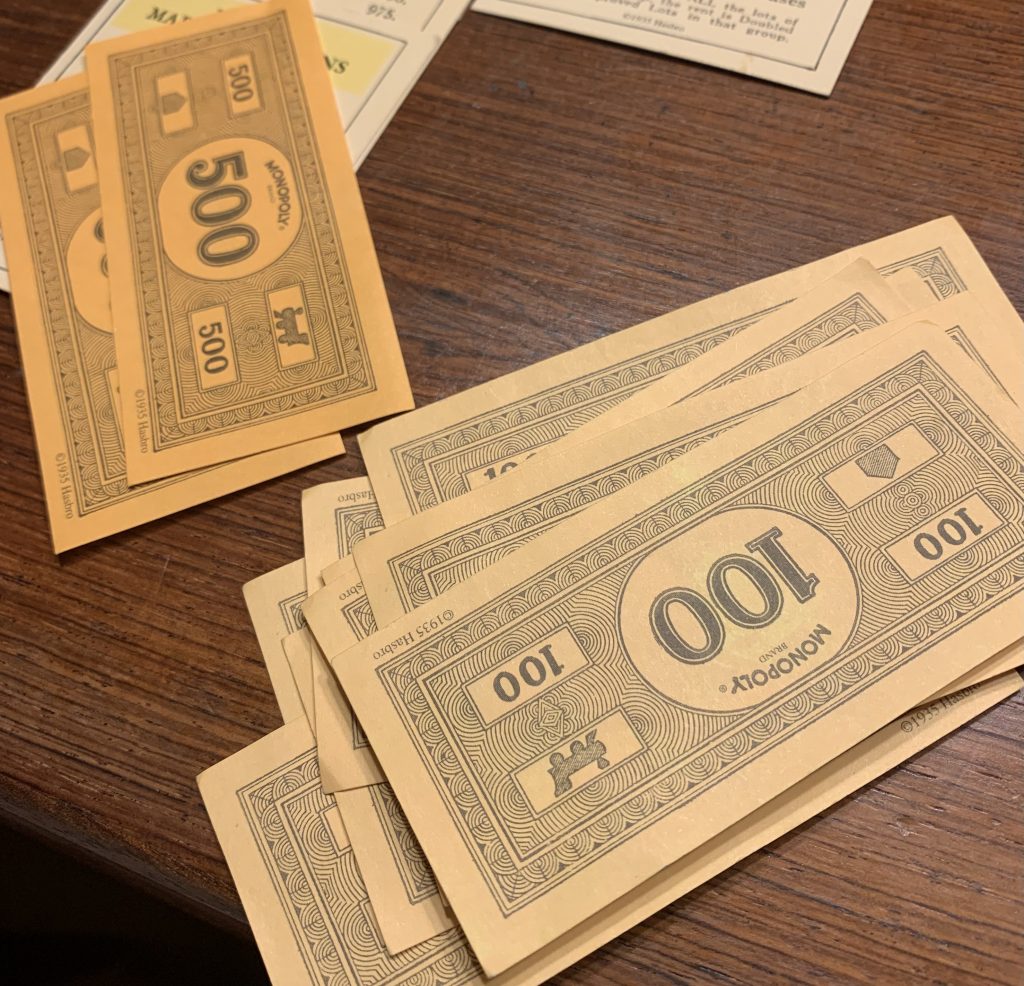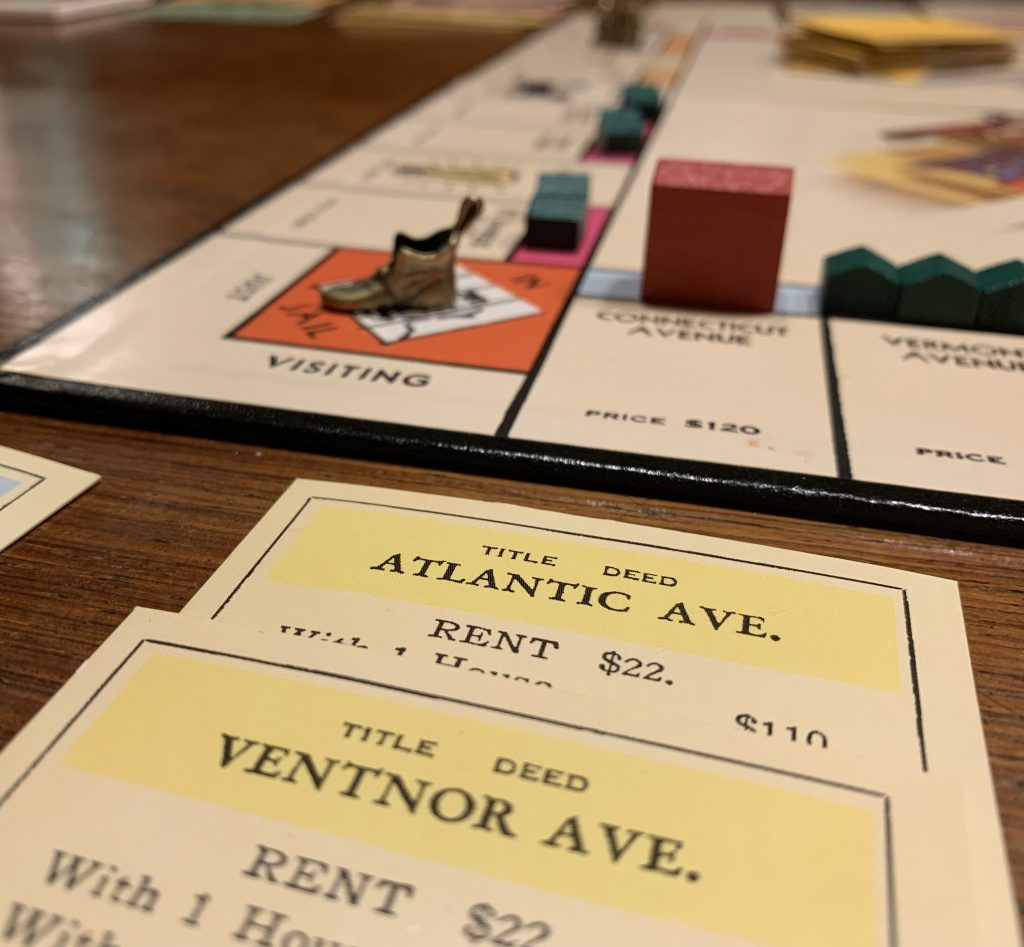I’m not sure what weekend family nights look like at your house, but at ours it fluctuates between movies or games. My eldest daughter follows my own passion for games, recently it was Mahjong and this week it was monopoly! Oh no, not monopoly I hear a plethora of parents cry! Oh yes, monopoly. The game that can go for hours, cause fights and tantrums, and end with money and game pieces all over the floor! However, in the words of Jon Scieszka and Lane Smith:
“You know, you can think of almost everything as a math problem!” (from the picture book Math Curse)
There are so many opportunities for mental mathematics within the game of monopoly. I’m not going to go into all the details of the tactics, the dice probability, and how to best make use of ‘making deals’ –although very mathematical– my focus is on the ‘basic’ more foundational mathematics that naturally occurs in the game and provide scope to teach and practice mathematical concepts. (As a side note: If you’d like to find out more about the mathematics of winning monopoly, Matt Parker (@standupmaths) has a great video I recommend you watch).
I’ve selected four concepts that I think monopoly has strong links to and in some cases reflects the contexts and use of the mathematical concepts in real-world scenarios. 1) number sense involving counting principles and place value; 2) percentages and decimals, particularly benchmark percentages such as 10%; 3) financial literacy and operating with money; and, 4) multiplication including doubling, ‘times by’ four and 10, and multiples of 100, 150, and 200. All of these concepts are usually developed in our primary curriculum. Students who can mentally work with the numbers and concepts presented in monopoly, have good mathematical fluency and flexibility with number, what we in NSW would call part of ‘working mathematically.”
Number sense
- Rolling the dice, adding the numbers, then moving the set number of spaces
- Noticing the patterns when moving a certain number of spaces eg if you are on a train station and roll a ten, you end up at the same position on the next side of the board (another train station)
- Noticing the patterns in houses and rent eg 1 house $90, 2 houses $180
- One-to-one correspondence – moving your piece the correct number of spaces on the board (without counting the space you are already on)
- Reading numbers on the money and on the property cards (up to four-digits)
- Counting by ones, fives, tens, twenties, 100s and 500s when dealing with money (this also links to financial literacy)
Percentages and decimals
- Understanding how to work out 10% of what you own when you land on income tax (this skill is really important, first the counting up or estimating of the money, then working out 10%, no calculator, year 5 students upwards should be able to develop an ability to know that 10% of 250 is 25)
- Using rounding to make the task easier if I have $255 in cash, I can’t pay $25.50, so round to $250 or $260 then work out 10%
- Reasoning about what’s the better deal $200 or 10% of everything (note we only make our children count their money, we leave the assets out to make the game friendlier)
Financial literacy (money)
- Reading various ways of writing money as amounts eg $140 compared with $75.00
- Connecting the total purchase price (eg $140) with the combinations of notes I have to use eg $100 and two $20s, or four $50s and two $20s
- Working out change eg rent is $16, you gave me a $20 so I’ll give you four $1 notes back
- Working out the best way to pay using knowledge of the notes eg I owe you $32, I’ll give you $52 and you give me a $20 back (and knowing why this might be a preferred option)
- Deciding which properties to buy based on their value, their rent return balanced with the cost of houses or hotels
- Ordering and organising money into denomination piles (or do you just make a messy pile of money?!)
Multiplication (and other operations)
- Using knowledge of doubles to work out the rent price when you own the whole colour set of properties (during our game today knowing two 28s are 56 became a new and ‘reusable’ piece of knowledge whenever anyone landed on North Carolina Ave)
- Working out (mentally) four times any roll when you own the Electricity company or the Water works, or 10 times if you own both – ‘times as many’ is another important mathematical concept (also learning how to think about efficiency – to work out 4 x $8, if you don’t automatically know it’s 32, doubling 8 and doubling again may be ‘easier’ than counting by 4s eight times – however what is ‘easier’ for some may be harder for others)
- Working out 2, 3, 4, and 5 times the house building rate when adding houses or hotels – these use nice benchmark amounts like $100, $150, $200 per house – great to solve mentally using either additive or multiplicative thinking
Whether you are up for the whole game or just want to use the game as a context in the classroom there is plenty of maths to be had in monopoly! You could even set up the board and ask students questions like: Who’s winning and how do you know? How much money does each player have? (estimate first) What number might player A need to roll to pass go? Which properties do you think are best to buy and why? Is it worthwhile to try to collect all the stations? Who much might all the houses on the board be worth? No matter if you love or hate this game (or games in general!) games can play a valuable role in assisting students to build the mathematical thinking skills and reasoning needed to be proficient.








